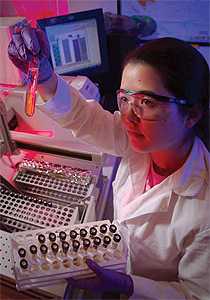CDC’s Environmental Health Laboratory
CDC 24/7: Saving Lives. Protecting People from Health Threats. Saving Money Through Prevention.
Environmental Health
Your environment is everything around you—the air you breathe, the water you drink, the community you live in, the places where your food is grown or prepared, your workplace, and your home. When your environment is safe and healthy, you are more likely to stay healthy. But when your environment exposes you to dangerous events or toxic substances, your health can be negatively affected.
CDC is committed to saving lives and protecting people from environmental hazards by responding to natural and man-made disasters, supporting state and city public health programs, educating communities, and advancing scientific knowledge. We help maintain and improve the health of Americans by promoting a healthy environment and preventing premature death and avoidable illness caused by environmental and related factors. We also identify how people might be exposed to hazardous substances in the environment and assess exposures to determine if they are hazardous to human health. CDC invests in prevention to improve health and save money by reducing health care costs. We strive to maximize the impact of every dollar entrusted to the agency.
Environmental Health Laboratory
CDC’s Environmental Health Laboratory provides unique laboratory science that improves the detection, diagnosis, treatment and prevention of diseases resulting from exposure to environmental chemicals and selected other diseases that require advanced laboratory measurement for accurate diagnosis.

The Environmental Health Laboratory supports:
| The Environmental Health Laboratory helps detect, diagnose, treat, and prevent disease through
|
Public Health in Action: Environmental Health Laboratory
Environmental Health Laboratory activities have resulted in substantial public health benefits:
| 
|
- Accurate testing for congenital diseases in more than 98% of newborns in the U.S. and correct identification of treatable diseases in approximately 6,000 babies yearly that may have otherwise died or been severely disabled.
- New, CDC-funded state screening programs and a diagnostic test improved by CDC identified more than 10 cases of severe combined immunodeficiency (SCID), a deadly disease that is treatable if detected early.
- Unique laboratory methods to test for botulism that
- are much faster and more sensitive than previous methods using mice,
- are used to verify vaccine effectiveness,
- have identified affected persons in multiple botulism outbreaks,
- provide exposure information in studies of clinical outcomes, and
- identified a previously unknown subtype, botulinum B7.
- Unique 24/7 chemical threat laboratory response capability that identifies human exposure to 150 chemical threat agents within 36 hours using CDC’s Rapid Toxic Screen.
- The Urine Radionuclide Screen can determine
- if persons have ingested or inhaled any of 10 priority radionuclides from poisoned food or water, a “dirty bomb,” or other release of radioactive material, and
- who should be treated and with what medical countermeasures.
- Using the Urine Radionuclide Screen, measurement of radiation exposures in Americans working in Japan during the Fukushima Daiichi Nuclear Power Plant radiation release found very low levels that posed no health threat.
- Page last reviewed: February 4, 2013
- Page last updated: February 4, 2013
- Content source:


 ShareCompartir
ShareCompartir